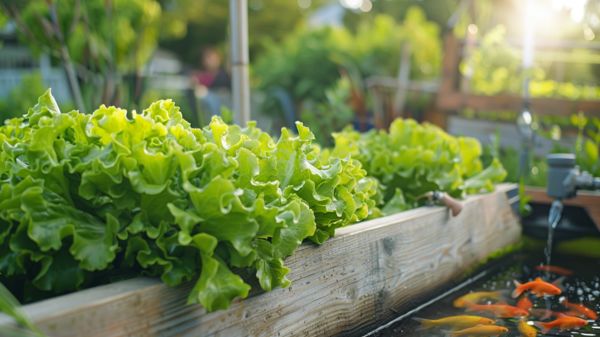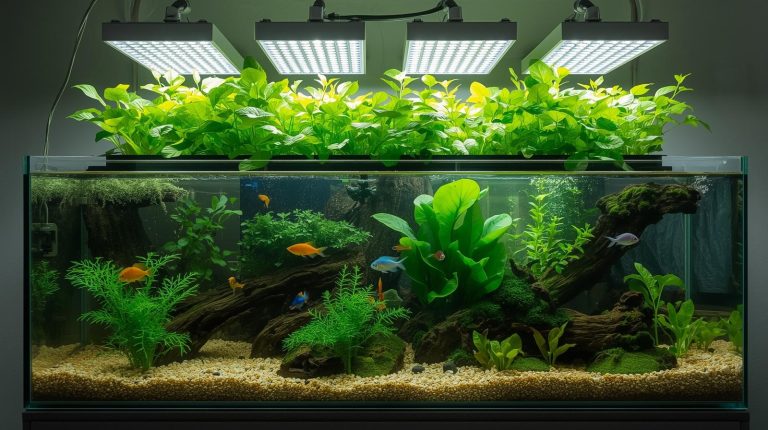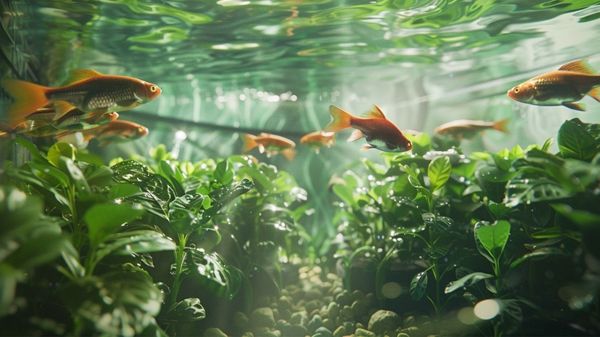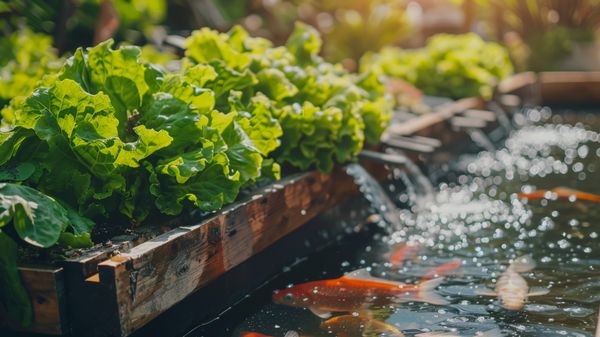Aquaponics integrates aquaculture and hydroponics to provide numerous benefits for sustainable living. You achieve significant water conservation, as this system uses up to 90% less water compared to traditional agriculture due to its closed-loop design. Waste is minimized through the recycling of nutrients from fish waste, which negates the need for synthetic fertilizers.
Additionally, this method enhances local food security by enabling year-round food production while lowering transport emissions and costs. The system also promotes biodiversity and engages communities in sustainable practices. To understand the full scope of these benefits, a more detailed examination will provide further insights.
Water Conservation Benefits
Many people don’t realize just how much water aquaponics can save compared to traditional farming methods. Aquaponics employs a sophisticated closed-loop system that minimizes water loss, resulting in remarkable efficiency gains.
In method comparison, traditional field-grown lettuce consumes approximately 4,224 gallons of water to produce the same quantity that aquaponics achieves with only 600 gallons; that’s a staggering 90% reduction in water usage.
This irrigation innovation leverages the natural interactions between fish and plants, continuously recirculating water and utilizing fish waste as a nutrient source, thereby further lessening reliance on external water resources. Additionally, aquaponics systems achieve water conservation through efficient recirculation practices, which enhance sustainability.
When considering average water usage, a typical 4,000-gallon aquaponics system can manage just 540 gallons per month, equating to about 18 gallons daily for producing 250-300 heads of lettuce. In contrast, traditional methods waste significant amounts of water due to evaporation and inefficient irrigation techniques.
Crop-specific aquaponics systems enhance this savings even more, varying from 0.40 to 0.49 cubic meters per kilogram of vegetables, ensuring that places with limited water supplies can still engage in sustainable food production and minimize their environmental impact.
Waste Reduction Strategies
Aquaponics not only conserves water but also offers strategies for reducing waste effectively. By maximizing fish feeding, you can minimize excess feed waste; feed your fish only what they can consume within five minutes.
Additionally, controlling stocking density prevents overcrowding, which can lead to excessive waste production. Proper plant management is significant; timely harvesting and removal of decaying matter help reduce solid waste accumulation.
Moreover, maintaining an appropriate plant-to-fish ratio is essential for maximizing nutrient uptake and overall system efficiency, as a balanced ratio ensures a sustainable ecosystem.
Utilizing efficient filtration systems is fundamental. Implement both physical and biological filtration to separate solid waste and maintain water quality. Regular maintenance of these systems guarantees ideal performance and minimizes waste issues, which contributes to a healthier aquaponics setup.
Waste tracking is essential in this process, allowing you to monitor water quality and adjust strategies as necessary.
Moreover, recycle solid waste by incorporating it into composting systems, transforming it into nutrient-rich organic fertilizers. This approach enhances nutrient efficiency, as beneficial bacteria convert fish waste into usable nutrients for your plants, creating a sustainable nutrient cycle.
Additionally, understanding water quality parameters is critical in maintaining system health and ensuring optimal conditions for both fish and plants.
Sustainability Advantages
Discover the remarkable sustainability advantages of aquaponics, where efficient resource use meets eco-friendly practices. By prioritizing resource conservation, aquaponics employs a closed-loop system that integrates aquaculture and hydroponics, drastically reducing reliance on external inputs.
The system recirculates water between fish tanks and grow beds, achieving up to 90% water savings compared to traditional farming methods, which minimizes waste and enhances water efficiency. This efficient model also allows systems to save up to 90% of water compared to conventional farming methods.
Moreover, with nutrients sourced from fish waste, aquaponics supports efficient nutrient recycling, eliminating the need for synthetic fertilizers and notably reducing chemical runoff into the environment.
This innovative approach fosters ecosystem support, enabling diverse plant and fish species to thrive together while promoting biodiversity and resilience within the agricultural space.
The strategic use of gravity within these systems not only contributes to lower energy costs but also highlights a commitment to resource efficiency, a guiding principle of sustainable practices.
Combined with year-round production capabilities, aquaponics offers a scalable method for food production that engages communities and nurtures a sense of interconnectedness with nature, making it an ideal choice for those who prioritize environmental stewardship in their daily lives.
Positive Environmental Impact
Building on the sustainability advantages previously discussed, aquaponics presents a range of positive environmental impacts that make it a compelling choice for modern food production. By utilizing a closed-loop system, aquaponics conserves water by recirculating it, achieving reductions in water usage by as much as 90% compared to traditional agriculture.
This method not only alleviates pressure on dwindling water resources but also minimizes soil erosion and nutrient runoff, thereby preserving ecological integrity. Moreover, aquaponics promotes biodiversity by allowing for a variety of fish and plant species to coexist, which enhances overall ecosystem health.
This biodiversity promotion bolsters resilience against pests and diseases, reducing the reliance on synthetic fertilizers and pesticides that harm the environment. Notably, aquaponics yields superior production volume, showcasing its effectiveness in sustainable food production.
Additionally, the closed-loop system of aquaponics contributes to sustainable water sourcing, further enhancing its environmental benefits. As you engage with aquaponics, you’ll also find it serves as a valuable platform for ecological education, offering hands-on experience in sustainable agriculture practices; this knowledge fosters a sense of belonging and stewardship towards environmental preservation.
Economic and Food Security
By integrating efficient resource management and innovative farming techniques, aquaponics prominently contributes to economic viability and food security. The system’s capacity for year-round production means that communities gain a consistent supply of fresh produce, greatly reducing reliance on imports, which in turn mitigates risks of supply disruptions.
Additionally, utilizing up to 90% less water than conventional agriculture enhances the sustainability of local investments and supports economic growth by promoting resource-efficient practices.
As aquaponics operates on a closed-loop system, it reduces operational costs, eliminating the need for synthetic fertilizers and chemical pesticides, making it a profitable venture for local producers. This method also allows for the cultivation of diverse plant and fish species, enriching biodiversity while fostering community resilience.
With food miles decreased due to local production, the environmental impact is thoughtfully minimized, and the approach effectively addresses food desert issues, ensuring that every community member has access to fresh, nutritious food. Furthermore, aquaponics provides a sustainable fish protein source, reducing pressure on wild fish stocks and contributing to healthier local diets.
Conclusion
Embracing aquaponics is like cultivating a thriving ecosystem in your own backyard, as it not only conserves water but also minimizes waste while promoting sustainable living. By integrating fish farming with plant cultivation, you create a symbiotic environment that enhances food security and reduces ecological footprints.
As you consider implementing this innovative approach, remember the substantial benefits it offers for both the environment and your community, ultimately fostering a more sustainable and resilient future.




